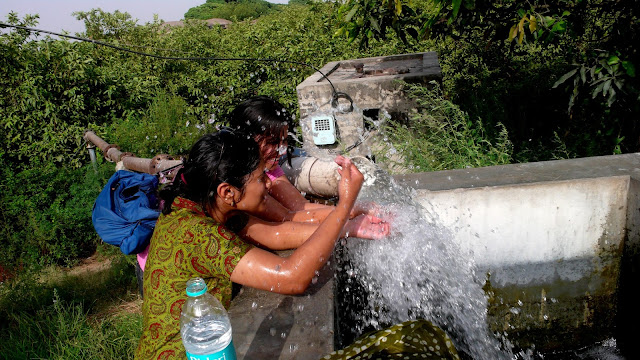Day 01
Date: 31st May
2012,Location: Aam Khas Bagh, Sirhind, Fatehgarh Sahib
Of practices and mal-practices
He (RaamKaran ji - the Gardener) said it happened a few years ago at a “Jor Mela” wherein people turned up in multiples of lakhs. The story goes that Fategarh Sahib is named after a story in itself.

The story within the Jor Mela Story is that Gurudwara Fatehgarh Sahib marks the land where the sons of the tenth Guru, Guru Gobind Singh, who were entombed alive. Fategarh Sahib is also the “City of Victory” named after Banda Bahadur. Banda Bahadur razed and overran the Mughal rule and gained control of the Fort built during Balban’s Rule.

So to commemorate this victory of the Sikhs over the Muslims, the Jor Mela is held every year where people gather in large numbers, nearing lakhs and run havoc over these Mughal Structures, dislodging the bricks from the buildings. Removing one nanakshahi brick per person is a customary act of faith.
It is much to the shock and regrets of conservationists that popular belief and faith can be detrimental to our built heritage, as we see that not only a heritage structure but even the modern one wasn't spared of this one.
It raised a lot of questions in my mind. Principally, was building a modern structure in historic precincts a recipe for disaster to begin with? If we build a boutique hotel in a Mughal Garden complex we would be catalyzing commercialization of the surroundings. As the tourist inflow increases, the ancillary facilities will increase. Like in most cases the growth could be uncontrolled, unforeseen, unplanned and mushroomed. Unless if we forcibly lay down guidelines for the facade treatment/ architectural vocabulary to be followed so that the streetscape around the complex doesn't turn into an abomination- which seemed highly unlikely as it would stimulate a high-maintenance and a premeditated involvement of urban/rural planning/development authorities of the state. As the infrastructure required to facilitate tourist inflow would increase, the urbanization could perhaps become an eye-sore and as was inevitable the agricultural landscape of the area might even get compromised. But there is a flip-side to this.
What if the hotel would end up being a grand failure? I feared that the amount of revenue that was going to be invested into building this structure may not reap as much profit from it. Does the community here really need a Spa and Recreation facility or is it just an eye-wash? Will they even use a hotel and if yes, then for how many months of the year? Probably just during the festival/ religious/ pilgrimage season. A commercial facility inside a historic complex just seems like fuel for a major row waiting to backfire. This was one lingering thought – an anticipated time bomb.

An afterthought of the sight of Aam Khas Bagh is that of how cultural practices and traditions can be detrimental to "built" heritage. The religious beliefs of the Sikhs and their devout following of their Gurus’ is a revered fact. But destruction of buildings to commemorate the martyrdom of the massacred children of their saint… even if we try to argue it intellectually, can we stop people from practicing what they believe in? If yes, how? Conservationists may hold their stead that this reinforces their perception that cultural practices if allowed in endangered/ dilapidated structures may be detrimental to the tangible architectural heritage of the region, but can anyone stop the people from dislodging these bricks as a custom?

No amount of fortification of the structures can stand the tide of time, faith or popular belief. It made me wonder that in a multicultural society such as India how does one resolve such issue and what do we keep as a higher priority over the other? Do we even need to resolve them? Isn’t architecture a manifestation of culture? Then whichever era that the Bagh was built in, if we argue to preserve the heritage of that era...what about the prevalent Sikh culture that encourages the Jor Mela and the symbolic vandalism associated with it? Their faith in their act is like our faith, our practices that evolve like our culture overtime… so how much of our tangible heritage needs preservation? And how much of it do we need to “let go” of.



No comments:
Post a Comment